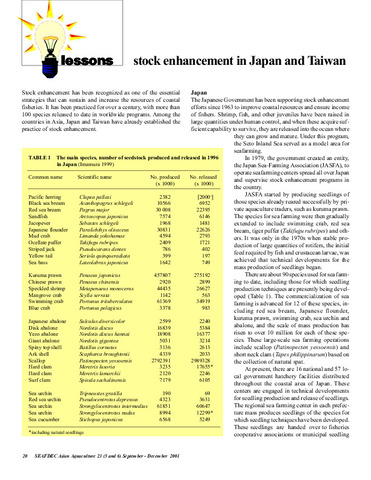Biotechnological researches at the Prefectural Fisheries Experimental Station in Japan

ရှာဖွေ/ဖွင့်ပါ။
ရက်စွဲ
1994စာရေးသူ
Page views
679
Share
စိတ္တဇ
Biotechnological studies have been conducted in 46 Prefectural Experimental Stations in Japan in 1991. In 41 of these, research focused on chromosome set manipulation including triploidy for sterilization and gynogenesis for sex control. Practical application of biotechnology for culture of each species is the main interest because each prefecture has its own project for promoting the local fisheries industry. Therefore, the commodities being studied are of commercial importance comprising of about 40 species.The culture production of Japan in 1988 totaled 1,426,000 tons, 95% of which consisted of 10 species. Biotechnology is not widely used since most seeds are not from hatcheries, but from the wild. Recently, however, promising results on the study of sex determination mechanism in the Japanese flounder have been adopted for actual seed production. This has attracted attention as an approach to mass production of all-female seedlings.
Suggested Citation
Kato, T. (1994). Biotechnological researches at the Prefectural Fisheries Experimental Station in Japan. In F. Lacanilao, R. M. Coloso, & G. F. Quinitio (Eds.), Proceedings of the Seminar-Workshop on Aquaculture Development in Southeast Asia and Prospects for Seafarming and Searanching; 19-23 August 1991; Iloilo City, Philippines. (pp. 68-74). Tigbauan, Iloilo, Philippines: Aquaculture Department, Southeast Asian Fisheries Development Center.
ဘာသာရပ်
စုစည်းမှုများ စုစည်းမှုများ
- ADSEA '91 [21]
Related items
Showing items related by title, author, creator and subject.
-
Coping with overcapacity/overfishing: Experience of Japan
Iwata, Tsuyoshi; Sulit, Virgilia T. (Secretariat, Southeast Asian Fisheries Development Center, 2016)Preventing the incidence of over-exploitation is a central element of fisheries management. Therefore, fisheries managers should be able to comprehend the degree of exploitation in a fishery resource and if managers fail ... -
Oyster-mussel farming in SEA, Japan, Cuba, and Scotland
Aldon, Eva; Buendia, Romeo (Aquaculture Department, Southeast Asian Fisheries Development Center, 1998) -
Stock enhancement in Japan and Taiwan
Adan, R. I. Y. (Aquaculture Department, Southeast Asian Fisheries Development Center, 2001)Stock enhancement has been recognized as one of the essential strategies that can sustain and increase the resources of coastal fisheries. It has been practiced for over a century, with more than 100 species released to ...




